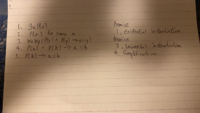alllovemewai
New member
- Joined
- Sep 28, 2020
- Messages
- 1
Recall that we can express unique existence as
(1) ∃x(P (x) ∧ ∀y(P (y) → x = y))
In many unique existence proofs, instead of proving (1), we prove the following:
(2) ∃xP (x)
(3) ∀x∀y(P (x) ∧ P (y) → x = y)
Your task here is to prove (1) from (2) and (3) using the rules of inference
for propositional and predicate logic.
I have tried it by different law but I am not sure the answer, I appreciate for someone help.
(1) ∃x(P (x) ∧ ∀y(P (y) → x = y))
In many unique existence proofs, instead of proving (1), we prove the following:
(2) ∃xP (x)
(3) ∀x∀y(P (x) ∧ P (y) → x = y)
Your task here is to prove (1) from (2) and (3) using the rules of inference
for propositional and predicate logic.
I have tried it by different law but I am not sure the answer, I appreciate for someone help.

